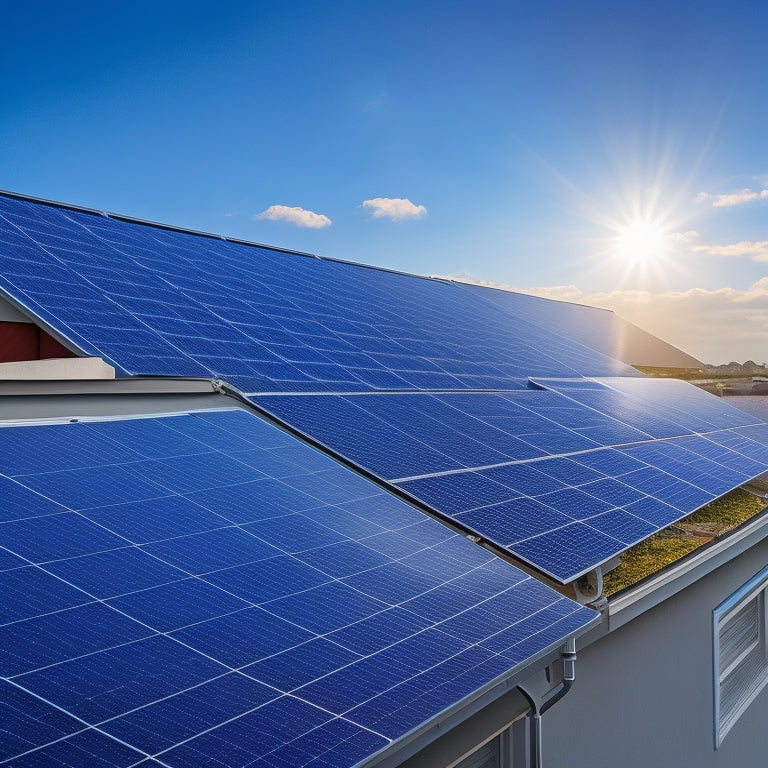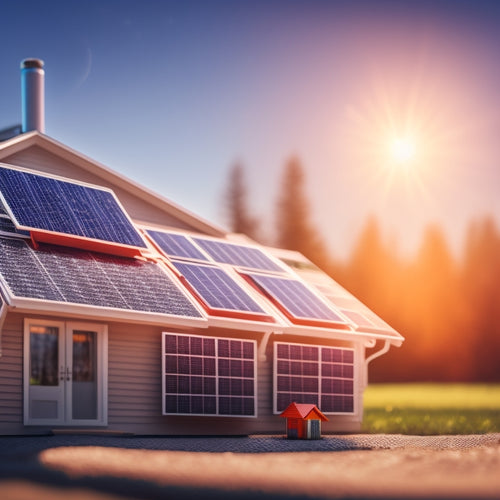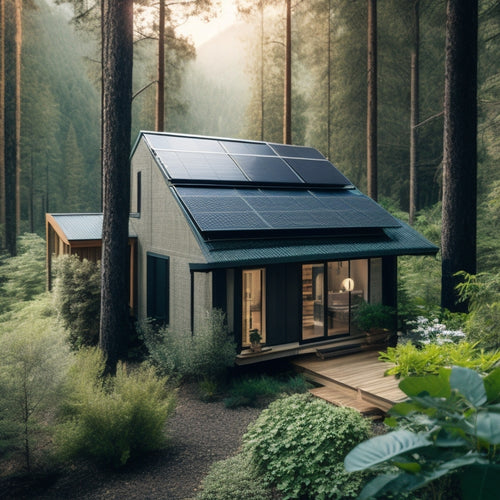
Solar Panel System With Battery
Share
You're investing in a solar panel system with a battery to utilize the power of the sun and take control of your energy usage, ensuring a reliable supply of clean energy when you need it most. This setup provides you with energy independence, reducing your reliance on non-renewable energy sources and shielding you from fluctuating grid prices and potential rate hikes. You'll also greatly lower your carbon footprint, contributing to a cleaner environment for future generations. As you investigate this technology, you'll realize the importance of deep cycle battery technology, evaluating your roof space, and planning for extended backup periods, and understanding these key factors will help you make the most of your solar panel system with battery.
The Essentials
- A solar panel system with a battery provides reliable power backup during outages and shields against fluctuating grid prices and rate hikes.
- Properly sized battery banks can extend backup periods, allowing storage of excess energy for low sunlight periods.
- Smart consumption optimizes real-time energy usage, eliminating dependency on utility company rates and outages.
- Deep cycle batteries withstand repeated charge/discharge cycles, essential for off-grid solar systems and home battery storage.
- A solar panel system with a battery significantly lowers carbon emissions, generating clean energy that offsets reliance on fossil fuels.
Increased Energy Independence Guaranteed
With a solar panel system, you're in control of your energy usage, generating power on your terms.
By utilizing the power of Home Solar Battery, you can store excess energy for later use, reducing your reliance on non-renewable energy and shielding you from fluctuating grid prices.
You'll also have a reliable power backup, ensuring your lights stay on during outages.
This means you'll experience increased energy independence, reducing your reliance on the grid and potential rate hikes.
Energy On Your Terms
Take control of your energy destiny by utilizing the power of solar energy. With a solar panel system, you're no longer at the mercy of your utility company's fluctuating rates and outages. You have the power to generate your own clean energy and store it for later use.
| Energy Freedom | Benefits | Features |
|---|---|---|
| Energy Storage | Reduce reliance on grid | Store excess energy generated during the day for use at night or during outages |
| Smart Consumption | Optimize energy usage | Monitor and adjust energy consumption in real-time to minimize waste |
| Renewable Energy | Reduce carbon footprint | Generate clean energy from the sun, reducing your reliance on fossil fuels |
Reliable Power Backup
Ditch the uncertainty of grid power and secure a steady supply of electricity with a reliable power backup system. You'll enjoy increased energy independence, free from the whims of utility companies.
A solar panel system with a battery guarantees you have power when you need it most. By leveraging advanced grid management technology, you can optimize your energy storage and reduce your reliance on the grid. This means you can power your home, office, or business without worrying about interruptions, and even alleviate the costs associated with peak-hour energy usage.
With a reliable power backup system, you can rest assured that your essential appliances will keep running during grid outages or natural disasters. Your battery maintenance routine will secure the system operates at peak performance, providing power reliability you can count on.
The system's advanced technology allows you to store excess energy generated by your solar panels during the day for use at night or during periods of low sunlight. This means you can power your home, office, or business without worrying about interruptions.
Reduced Carbon Footprint Guaranteed
By switching to a solar panel system, you'll greatly reduce your carbon emission reduction, which is an essential step towards minimizing environmental impact.
With solar energy, you'll produce clean electricity, offsetting your reliance on fossil fuels and lowering your carbon footprint.
In fact, residential solar panels can provide a considerable portion of your home's energy needs, reducing your dependence on the grid.
As a result, you'll contribute less to greenhouse gas emissions, playing an important role in mitigating climate change.
Carbon Emission Reduction
Your solar panel system plays an essential role in reducing your carbon footprint, and with it, you can considerably decrease your reliance on fossil fuels. By utilizing renewable energy from the sun, you're adopting a sustainable approach that mitigates climate change.
As a responsible individual, you're taking a significant step towards minimizing your environmental impact.
The carbon reduction strategies employed by your solar panel system are twofold. To begin with, it reduces your dependence on fossil fuels, which are the primary contributors to greenhouse gas emissions.
In addition, it generates clean energy, which offsets the carbon emissions produced by your daily activities. By integrating your solar panel system with a battery, you can store excess energy for later use, further minimizing your reliance on the grid.
Environmental Impact Minimized
With every kilowatt-hour of solar energy you capture, you're actively shrinking your carbon footprint. By utilizing the power of sustainable technologies and renewable resources, you're reducing your reliance on fossil fuels and minimizing your environmental impact. This is especially essential in the current era, where climate change and pollution pose considerable threats to our planet's ecosystem.
Here's a breakdown of the environmental benefits of solar energy:
| Category | Solar Energy | Fossil Fuels |
|---|---|---|
| Greenhouse Gas Emissions | 0 kg CO2e/kWh | 1,001 kg CO2e/kWh |
| Air Pollution | 0 kg NOx/kWh | 1.3 kg NOx/kWh |
| Water Usage | 0 liters/kWh | 1,020 liters/kWh |
| Land Use | 3.5 acres/MW | 12.5 acres/MW |
| Waste Generation | 0 kg/kWh | 10 kg/kWh |
As you can see, solar energy offers a markedly cleaner and more sustainable alternative to traditional fossil fuels. By switching to a solar panel system with a battery, you're not only reducing your carbon footprint but also contributing to a cleaner, healthier environment for generations to come.
Deep Cycle Battery Technology
You'll want to take into account the battery cycle life when selecting a deep cycle battery for your solar panel system, as it directly impacts the overall performance and lifespan of your energy storage solution.
The advantages of deep cycle batteries lie in their ability to withstand repeated charge and discharge cycles, making them ideal for off-grid solar systems.
In fact, deep cycle batteries are an essential component of home battery storage solutions, allowing homeowners to store excess energy generated by their solar panels during the day for use at night or during power outages.
Battery Cycle Life
Several hundred charge and discharge cycles are typically guaranteed by deep cycle battery manufacturers, a proof of their ability to withstand the rigors of frequent use. This guarantees that your solar panel system with battery remains efficient for an extended period.
As you use your deep cycle battery, it's crucial to follow proper battery maintenance practices to maximize its lifespan. This includes monitoring the state of charge, avoiding deep discharges, and keeping the battery terminals clean. By doing so, you can expect your deep cycle battery to last for 5-7 years or more, depending on the manufacturer's specifications.
It's also important to note that the battery's lifespan will vary depending on factors such as temperature, depth of discharge, and charging/discharging rates. Regularly inspecting and maintaining your battery will help you identify potential issues early on, allowing you to take corrective action and extend its lifespan.
Advantages of Deep
Your deep cycle battery's ability to provide a stable and reliable source of energy is largely due to its advanced technology. This technology allows for a deeper discharge of the battery, making it more efficient and effective.
You'll appreciate the advantages of deep cycle batteries, especially when it comes to battery maintenance. With a deep cycle battery, you can expect fewer maintenance requirements, as it's designed to handle the rigors of daily charging and discharging.
Deep cycle batteries are built to last, with a longer lifespan compared to traditional batteries. This means you'll replace them less often, saving you time and money.
Additionally, deep cycle batteries are designed to handle the fluctuations in power output from your solar panel system, ensuring a consistent flow of energy. You'll experience fewer power outages and interruptions, giving you the freedom to live life on your own terms.
Consider Your Roof Size
When considering a solar panel system, you'll need to assess your roof's space to determine its suitability for solar panels.
You'll want to calculate the available roof area to guarantee it can accommodate the required number of panels, considering factors such as energy efficiency solutions renewable energy systems and the size of the photovoltaics.
Roof Space Assessment
Roof dimensions play an essential role in determining the feasibility of a solar panel system installation. You need to assess your roof space to verify it can accommodate the required number of solar panels.
When evaluating your roof, you'll want to take into account its orientation. A south-facing roof is ideal, as it receives the most direct sunlight throughout the day. If your roof doesn't face south, don't worry - solar panels can still be installed on east- or west-facing roofs, but you may need more panels to generate the same amount of energy.
Next, you'll need to perform a shading analysis to identify any obstructions that could impact energy production. Trees, chimneys, and neighboring buildings can all cast shadows on your roof, reducing the system's efficiency.
You'll want to assess the shading patterns throughout the day and year to determine the best placement for your solar panels. By understanding your roof's dimensions, orientation, and shading patterns, you can optimize your solar panel system's design and maximize its energy output.
Available Roof Area
Evaluating the available roof area is a critical step in determining how many solar panels can be installed. You'll need to evaluate your roof's size, shape, and orientation to determine the available space for solar panels.
Take into account the roof orientation, as a south-facing roof receives the most sunlight throughout the day, making it ideal for solar panels. However, if your roof faces east or west, you can still install solar panels, but the energy output may be slightly lower.
Conduct a shading analysis to identify any obstructions, such as trees, buildings, or vents, that could reduce the amount of sunlight reaching your roof. This will help you determine the best placement of solar panels to maximize energy production.
Measure the length and width of your roof to calculate the total available area. You'll also need to take into account any roof features, such as skylights, vents, or chimneys, that may take up space or create shading issues.
Longer Power Backup Times
When you're designing a solar panel system, you'll want to contemplate how long you need backup power to last in case of an outage.
With a battery bank that's properly sized, you can extend your backup period to several days or even weeks.
Extended Backup Period
With the rise of renewable energy, homeowners and businesses are increasingly relying on solar panel systems to power their daily operations.
As you contemplate investing in a solar panel system with a battery, you likely want to maximize your power backup times. This is where an extended backup period comes in.
An extended backup period allows you to store excess energy generated by your solar panels during the day for use during extended periods of low sunlight or at night. This is particularly useful for homeowners who live in areas with frequent power outages or those who rely heavily on critical loads like refrigeration or medical equipment.
To achieve an extended backup period, you'll need to deliberate battery maintenance and cost considerations. For instance, you may need to invest in a larger battery bank or more efficient charging systems. Additionally, you'll need to factor in the cost of replacing batteries over time.
Frequently Asked Questions
Can I Use Any Type of Battery With My Solar Panel System?
You'll need to guarantee the battery you choose is compatible with your solar panel system, as mismatched components can hinder solar efficiency; research and select a battery that meets your system's specific voltage and capacity requirements.
How Long Does It Take to Charge a Deep Cycle Battery Fully?
You'll find that fully charging a deep cycle battery depends on its capacity, charger's power, and charging efficiency; with proper battery maintenance, a 200Ah battery takes around 4-6 hours to fully charge with a 50A charger, assuming 90% charging efficiency.
Are Solar Panels With Batteries Noisy During Operation?
When you operate solar-powered systems, you'll notice minimal solar noise, as most components are quiet or silent; however, some inverters or charge controllers might produce a soft hum, but this won't compromise your battery efficiency or freedom.
Can I Install a Solar Panel System With Battery Myself?
You're a trailblazer, charting your own course, but DIY installation requires careful guidance; make certain you're compatible with the battery's unique needs, or your system will be a shipwreck, lost at sea, without the direction of a seasoned pro.
Will a Solar Panel System With Battery Increase My Property Value?
You're wondering if enhancing your home's energy efficiency and property appeal through eco-friendly upgrades will pay off. Yes, they will; a solar panel system with battery can increase your property value, making your home more attractive to potential buyers.
Final Thoughts
With a solar panel system paired with a deep cycle battery, you'll enjoy increased energy independence and a reduced carbon footprint. For instance, a homeowner in California with a 5 kW solar array and a 10 kWh battery can power their home for 8 hours during an outage, while also reducing their carbon emissions by 5 tons annually. By considering your roof size and energy needs, you can maximize the benefits of this reliable and eco-friendly solution.
Related Posts
-

A Beginner's Guide to Navigating the Solar Investment Tax Credit
You're eligible to claim a significant Solar Investment Tax Credit (ITC) of 30% of total installation costs, but mane...
-

Off Grid Solar Batteries
As you shift to off-grid living, you'll rely on high-performance solar batteries to store excess energy generated by ...
-

Top Solar Powered Camping Fans for Camping Enthusiasts
If you're a camping enthusiast, a solar-powered fan can be a transformative element for your outdoor experience. Thes...


